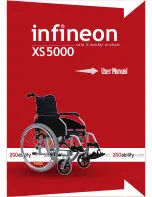
7
GB
WW* = Wrench width [mm]
BACKREST
The backrest can be folded and its angle
can be adjusted by approx. ± 10°
(Fig.19).
Benefits:
– Relief for the spinal column.
– Relaxed sitting position.
– Smaller transport dimensions.
Folding:
– Remove seat cushion.
– Fold side parts inwards (Fig.19).
– Unlatch the backrest. – Pull or press
pull rope (A, Fig.20) downwards.
– Fold backrest onto the seat (Fig.18).
– Press the backrest forwards over
the latching point.
Unfolding:
– To unfold, pull the handle with a jerk
to the rear up to the end stop. – The
thrust bolts must audibly click into
place.
– Fit the clothing guards or unfold the
side parts:
+
Remark:
The greasing of the thrust bolts is
recommended for an easier latch-
ing of the backrest.
Angle adjustment:
The angle adjustment occurs after the
locking pieces (B, Fig.21) have been
undone.
Tools:
1x open-end spanner WW* 13 and
17
– Fold side parts inwards (Fig.19).
– Undo the lock nuts (D, Fig.22) of the
end stop screws in the frame tube.
– Screw in end stop screws (C,
Fig.22) if necessary.
– Undo the lateral locking pieces (B,
Fig.21).
– Place backrest in the new position.
– Tighten the locking pieces (B,
Fig.21). – The key faces of the lock-
ing pieces must be positioned almost
parallel to the driving surface (E,
Fig.22) in order to ensure a latching
via the facing angles.
– Screw out the end stop screws (C,
Fig.22) up to the end stop.
– Tighten the lock nuts (D, Fig. 22).
– Fit the clothing guards.
BACKREST BELT
The backrest belt slackness can be ad-
justed to the personal needs of the user
by way of the Velcro fastener (Fig.23).
Backrest height adjustment
– Pull the backrest belt off the Velcro
strips and wrap it forwards.
– Remove screw connection (D,
Fig.23).
– Slide the adjustment tubes to the de-
sired hole position.
– Assemble screw connection (D,
Fig.23).
– Re-fasten the backrest belt.
SEAT
The seat (A, Fig. 24) is fixed with Velcro
fasteners and can be removed (Fig.
25).








































